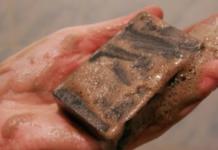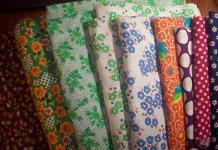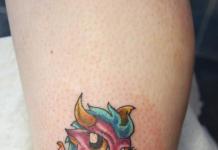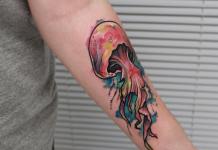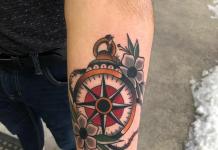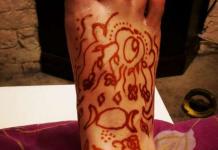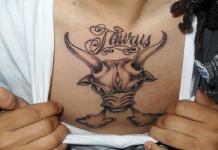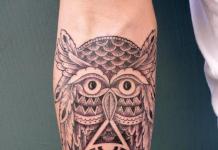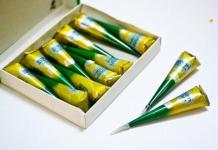Maddison and her mom got a tattoo at the Huragada hotel while on holiday in Egypt
Paired henna tattoos that the girl did with her mother

But after returning to England, the girl had a severe allergic reaction and her arm became covered with blisters.

As you know, black henna can contain large amounts of paraphenylenediamine, a highly toxic chemical.
Although paraphenylenediamine is also found in many products, such as sunscreens and hair dyes, it is used in very small doses.
The paraphenylenediamine in henna is now recognized as a public health problem, as the allergenic chemical often causes negative reactions in hypersensitive children.
The father of the family, Martin, said that they were vacationing in Egypt with his 43-year-old wife Sylvia, 9-year-old son Sebastian and 7-year-old Madison

Sylvia had to spend a couple of days of vacation in the hospital due to a gallbladder infection. Upon returning from the hospital, as an encouragement that the children were well behaved, Martin decided to cheer them up by allowing them to get black henna tattoos.
Sebastian immediately complained of a burning sensation, so the tattoo from his arm was immediately washed off with water. Madison only complained about the tattoo after returning to England.

“We saw that there were some wounds on top of the tattoo, but we did not see redness. The next morning, the place of the tattoo began to itch a lot, and when we understood it with water, we saw redness along the contour of the tattoo,” said Martin.
"Her arm started to blister, so we decided to read about black henna tattoos on the internet, and only then did we realize how dangerous it is," Martin continued.

Doctors prescribed steroid creams and ointments to the girl, which did not give a positive result, and the girl's hand continued to become covered with huge blisters.
As a result, Madison was admitted to the hospital in the burns unit.

Doctors conducted an examination, finding a high PH level in the girl, which indicated a chemical burn.
Doctors tried to treat the girl's skin in this condition, but the blisters were so large that the treatment did not reach the affected skin under them. So they had to remove the fluid bubbles first.
After the operation, the girl was bandaged and transferred to the scar care unit. Now she will have to walk with this bandage for at least 6 months to minimize the size of the scars.

"We emailed the hotel but were told that there is nothing wrong with henna and that our daughter is most likely the problem. I then responded with a link to the dangers of black henna tattooing and recommended that they talk to their doctor, who was trained in Britain," Martin said.
"We don't want compensation, what matters is Madison's health and minimizing her scarring, because we don't want her to grow up with scars that she will have for life," he continued.
Later, the Huragada hotel sent a message apologizing to Martin and his family and saying that they no longer offer henna tattoos to their customers.
Mice are very small and nimble animals, so it will not be difficult for them to get into the dwelling. Most often, the invasion begins in the fall, with the onset of cold weather, but if the house has all the favorable conditions for their existence, then they can come at any time.
The reason for the penetration and spread of rodents in the house is always the same - unsanitary conditions. They are attracted by the leftover food on the floor, the table, the garbage that was not taken out on time, but it will also not be difficult for them to open plastic and cardboard boxes with supplies.
The presence of mice can be determined by several signs:
- incomprehensible night noises (squeaking, rustling);
- gnawed packs and packages;
- musty (mouse) smell;
- feces on the floor and shelves near food.
Cohabitation with rodents is not only morally unpleasant, but often life-threatening. Mice are capable of carrying diseases that can be fatal to humans, and the saliva of animals contains microbes that cause severe poisoning. In addition to infections, rodents can bring fleas with them.
In addition, mice can cause a short circuit and, as a result, a fire if the wires are damaged.
Bank and coin how to make a mousetrap
Another version of the device for catching mice from a jar, this time with a button or a coin. Just like the previous option, the jar will not kill, but will only help to catch rodents in a humane way.
The principle of operation is more than simple. A button, coin or any puck is used as a support, lifting the jar (can be replaced with a pan or bucket). A strong thread with a hook is tied to the support, a rod is placed inside the container to fix the thread, and a bait is put on the hook. The smell of the treat will attract the mouse to the jar, she will pull the hook, the thread will stretch and drop the puck as a support, as a result of which the rodent will be trapped unharmed.
By the same principle, a trap can be made from a box, for example, from under a cake. A hole is made in the lid exactly in the middle, where they insert half of the stick with a cotton swab at the end so that it is outside, and the part without the swab is inside the box with the bait.
Any weight is placed on the lid of the box, it can prevent the mouse from trying to get out after the trap slams shut. A bait is attached to a stick inside the box, the edge of the lid is lifted and placed on a small support. The rodent will be attracted by the smell of the bait, it will climb into the box, and when it tries to remove the food from the stick, the box with the weight on the lid will close.
Such homemade mousetraps are quite effective, but they have one significant drawback - they work once, which means they are able to catch one mouse.
//www.youtube.com/watch?v=-1SoXy2gY3o
How to make a bottle trap
What the fantasy of craftsmen does not reach when it comes to plastic containers for liquid products. Not without them and catching rodents. A plastic bottle trap is made in just a few minutes. You can make it from a poltorashka or a container of 2 liters. In the absence of the latter, mouse traps are constructed from a 5-liter bottle. Traps can be made in several ways.

Trap for rodents from a plastic bottle
Option number 1
The walkthrough looks like this:
- Using a clerical knife, cut off the neck of a plastic vessel, approximately a third.
- Lubricate the cut neck from the inside with any vegetable oil.
- Put the bait inside the remaining part with the bottom.
- Turn the element with a neck so that it is directed down the structure and secure it with tape or wire.
The mouse, tempted by the aroma of the bait, freely penetrates through the greased neck into the trap, but will not be able to get back. On the part of the neck where the cork is screwed, several fan-shaped vertical cuts can be made. This will increase the chances of catching a large rodent.
On a note!
So that the mousetrap from a plastic bottle does not turn over, a weighting agent is placed on the bottom: stones, a small bag of sand.
Option number 2
Catching a mouse in a bottle is even easier:
- Cut off the top of the container where the constriction ends.
- On the upper edge of the element with a bottom, make cuts 4-5 cm long with an interval of 1.5-2 cm. You will get a semblance of petals that need to be sharpened.
- Bend the pointed edges down so that they look at the bottom.
- Lubricate the walls of the trap with fat and put the bait on the bottom.
For the convenience of the mouse, small boards are attached to the device. The animal will climb them without interference, fall into the vessel, and sharp edges and slippery walls will not allow it to leave.
On a note!
A primitive trap is easy to make if you put the bait in a bottle of oil after using the product and slightly cut off the neck and bend it down.
Option number 3
This type of trap is somewhat different from the previous ones:
- Cut off the neck of the bottle and throw it away. This part is no longer needed.
- In the resulting container, it is necessary to drill two holes and stretch a rope or wire through them, through which the mousetrap will be tied.
- Place the bait at the bottom and position the trap so that part of it hangs from a shelf or countertop. Fix fastening.
As soon as the mouse climbs for a treat, the center of gravity will shift, and the mousetrap will invariably hang with the captive. Catching pests with bottles is quite convenient. Consumables for their manufacture cost nothing, and captured animals can be disposed of along with the trap, which avoids direct contact with them.
A simple plastic container trap manufacturing algorithm
A more than simple, and most importantly, humane way to catch rodents at home is to make a trap out of a plastic container. To do this, you will need the following elements:
- plastic bottle;
- thread or rope;
- bait.
A mousetrap is constructed from a plastic bottle simply. The neck is cut off at the container, two holes are made for attaching the thread. The bait is placed inside. One part of the thread is tied to the load or glued to the edge of the table. The container is placed on the table in such a way that most of it hangs from it.
As soon as the mouse comes to the aroma of the bait, it will climb into the bottle and gravity will play a role here - the bottle will fall to the floor along with the rodent, hover above the floor due to the correctly selected length of the thread. Caught prey can be released away from home without stress for her and the household.

Harm from mice
There are several reasons for dealing with these pests. Firstly, many are afraid of mice, especially housewives. When mice appear, they panic. In addition, there are a number of factors that are decisive. For example:
- Damage to household items. They were called rodents not in vain, since they are able to gnaw on objects in the house, regardless of the material of manufacture. It can be furniture, electrical wires, children's toys, shoes, etc. They especially love styrofoam. If someone has made repairs and foam was used as a heater, then you need to be prepared to receive such pests.
- Possibility of fire. Mice can easily eat the insulation of electrical wires, which can eventually lead to a short circuit and a fire. They can gnaw on the power wires of many electrical appliances, so you need to regularly inspect them for the integrity of the insulation.
- The presence of pathogenic microorganisms. The saliva of rodents can contain various microorganisms that can cause typhus, cholera, plague, or ordinary poisoning. In addition, mice are carriers of fleas that prefer to feed on human blood.
- Rodents spoil food and water. This is because mice leave traces of their vital activity everywhere in the form of feces, which are saturated with bacteria and viruses. If the animal drank water from a cup, then it can be hazardous to health.
- Mice leave a foul odor behind. This is a kind of "mouse" smell, which is distinguished by its peculiarity. It is on it that you can determine that there are mice in the house. If it is absorbed into furniture or some things, then it is quite difficult to get rid of it. Some people may experience allergy attacks, which are expressed in the form of vomiting. In any case, this leads to constant discomfort.
THIS IS IMPOSSIBLE TO BELIEVE! Parents were shocked, because they did not know what they were from. Upon learning the truth, the young mother and father were speechless. The fact is that this is a consequence ...

It's no secret that tattoos can be a very dangerous business, but as it turns out, temporary henna tattoos are also fraught with serious dangers. Little girl Madison Gulliver will be left with monstrous patterned scars on her arm for the rest of her life due to a henna tattoo she got with her mother and brother in Egypt. Here they are, in fact:
After returning to her homeland, to England, the girl had a severe allergic reaction and her hand became covered with blisters. As you know, black henna can contain large amounts of paraphenylenediamine, a highly toxic chemical.

Although paraphenylenediamine is also found in many products, such as sunscreens and hair dyes, it is used in very small doses.
The paraphenylenediamine in henna is now recognized as a public health problem, as the allergenic chemical often causes negative reactions in hypersensitive children.

The father of the family, Martin, said that they were vacationing in Egypt with his 43-year-old wife Sylvia, 9-year-old son Sebastian and 7-year-old Madison. Sylvia had to spend a couple of days of vacation in the hospital due to a gallbladder infection. Upon his return from the hospital, as an encouragement that the children were well behaved, Martin decided to cheer them up by allowing them to get black henna tattoos.
Sebastian immediately complained of a burning sensation, so the tattoo from his arm was immediately washed off with water. Madison began to complain about the tattoo only after returning back to England. “We saw that some wounds appeared on top of the tattoo, but we did not see any redness.

The next morning, the place of the tattoo began to itch a lot, and when we understood it with water, we saw redness along the contour of the tattoo, ”said Martin.
“Her hand began to blister, so we decided to read about black henna tattoos on the Internet, and only then we realized how dangerous this thing is,” continued Martin.
Doctors prescribed steroid creams and ointments for the girl, which did not give a positive result, and the girl's hand continued to become covered with huge blisters.

After the operation, the girl was bandaged and transferred to the scar care unit. Now she will have to walk with this bandage for at least 6 months to minimize the size of the scars.
Nine-year-old Madison will be left with monstrous patterned scars on her arm for the rest of her life due to a henna tattoo she got with her mom and brother in Egypt. The family was vacationing in Hurghada. According to the girl's father, his wife Sylvia had to spend several days in the hospital due to a gallbladder infection. Upon her return, as a reward for the children's good behavior, the woman decided to reward them and offered to get black henna tattoos. From the very beginning of the holiday, children showed great interest in such tattoos.
The girl's younger brother Sebastian immediately complained of a burning sensation, so the tattoos were washed off his arm. Madison began to complain about the tattoo only after returning back to England.
We saw that some wounds appeared on top of the tattoo, but we did not see any redness. The next morning, the place of the tattoo began to itch a lot, and when we understood it with water, we saw redness along the contour of the tattoo, says the girl's father, Martin. - Her arm started to blister, so we decided to read about black henna tattoos on the Internet, and only then we realized how dangerous it is.
As it turns out, black henna can contain large amounts of paraphenylenediamine, a highly toxic chemical. Although paraphenylenediamine is also found in many products, such as sunscreens and hair dyes, it is used in very small doses. The addition of paraphenylenediamine to henna is now recognized as a public health problem, as the allergenic chemical often causes negative reactions in hypersensitive children.
Doctors prescribed steroid creams and ointments for the girl, which did not give a positive result, and the girl's hand continued to become covered with huge blisters. As a result, Madison was admitted to the hospital in the burns unit. Doctors conducted an examination, finding a high level of PH in the girl, which indicated a chemical burn. Doctors tried to treat the girl's skin in this condition, but the blisters were so large that the treatment did not reach the affected skin under them. So they had to first remove the fluid bubbles.
After the operation, the girl was bandaged and transferred to the scar care unit. Now she will have to walk with this bandage for at least 6 months to minimize the size of the scars.
We sent an e-mail to the hotel, but they were told that there is nothing wrong with henna and that most likely the problem lies in our daughter, the parents said. “After that, I responded to them by sending a link to the dangers of black henna tattooing and recommending that they talk to their doctor, who was trained in Britain. We don't want compensation, what matters is Madison's health and minimizing her scarring, because we don't want her to grow up with scars that will stay with her for the rest of her life.
Later, the Huragada hotel sent a message apologizing to Martin and his family and saying that they no longer offer henna tattoos to their customers.
Nine-year-old Madison will be left with monstrous patterned scars on her arm for the rest of her life due to a henna tattoo she got with her mom and brother in Egypt. The family was vacationing in Hurghada. According to the girl's father, his wife Sylvia had to spend several days in the hospital due to a gallbladder infection. Upon her return, as a reward for the children's good behavior, the woman decided to reward them and offered to get black henna tattoos. From the very beginning of the holiday, children showed great interest in such tattoos.
The girl's younger brother Sebastian immediately complained of a burning sensation, so the tattoos were washed off his arm. Madison began to complain about the tattoo only after returning back to England.
We saw that some wounds appeared on top of the tattoo, but we did not see any redness. The next morning, the place of the tattoo began to itch a lot, and when we understood it with water, we saw redness along the contour of the tattoo, says the girl's father, Martin. - Her arm started to blister, so we decided to read about black henna tattoos on the Internet, and only then we realized how dangerous it is.


As it turns out, black henna can contain large amounts of paraphenylenediamine, a highly toxic chemical. Although paraphenylenediamine is also found in many products, such as sunscreens and hair dyes, it is used in very small doses. The addition of paraphenylenediamine to henna is now recognized as a public health problem, as the allergenic chemical often causes negative reactions in hypersensitive children.
Doctors prescribed steroid creams and ointments for the girl, which did not give a positive result, and the girl's hand continued to become covered with huge blisters. As a result, Madison was admitted to the hospital in the burns unit. Doctors conducted an examination, finding a high level of PH in the girl, which indicated a chemical burn. Doctors tried to treat the girl's skin in this condition, but the blisters were so large that the treatment did not reach the affected skin under them. So they had to first remove the fluid bubbles.

After the operation, the girl was bandaged and transferred to the scar care unit. Now she will have to walk with this bandage for at least 6 months to minimize the size of the scars.
We sent an e-mail to the hotel, but they were told that there is nothing wrong with henna and that most likely the problem lies in our daughter, the parents said. “After that, I responded to them by sending a link to the dangers of black henna tattooing and recommending that they talk to their doctor, who was trained in Britain. We don't want compensation, what matters is Madison's health and minimizing her scarring, because we don't want her to grow up with scars that will stay with her for the rest of her life.
Later, the Huragada hotel sent a message apologizing to Martin and his family and saying that they no longer offer henna tattoos to their customers.



